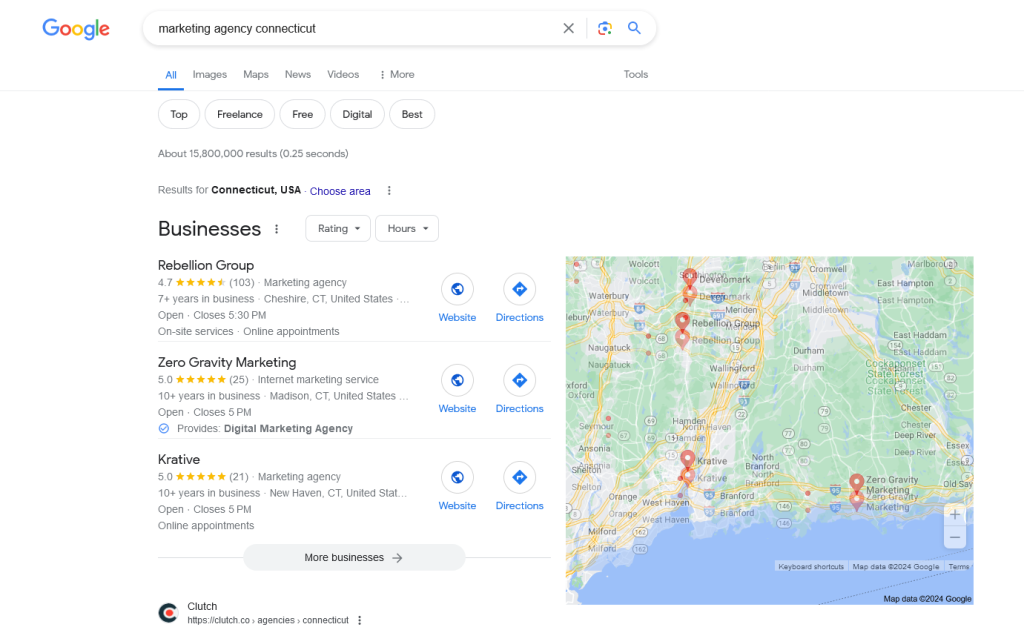SEM, Google and SEO: Everything You Need to Know
Those who work in digital marketing have certainly heard the three words in the same sentence: SEM, Google, and SEO.
These are the buzzwords of the moment, describing the three most focused points in most mature traffic generation strategies nowadays.
But I’m not trying to say that these words are the only ones that make sense for modern digital marketing. There are other strategies and ad formats that are just as important as those focusing on Google.
In the end, SEM, Google, and SEO are describing a constant concern in the lives of marketing professionals: appearing in search engines and generating leads and sales through them.
In today’s article, we will delve a little deeper into these two concepts—SEM and SEO—understand their differences, and talk a bit more about Google as well.
Shall we begin?
What is SEM?

First, the most basic definition: what exactly is SEM?
Well, the acronym itself explains a lot. SEM stands for Search Engine Marketing.
Today, the term SEM mainly describes paid strategies for generating traffic, leads, and sales through Google, primarily through Pay Per Click strategies using Google Ads.
Working in SEM is like entering a new market—the Google market. It’s about being presented in the search engine as a viable solution for users when they’re searching.
It’s the same as taking your brand to any market, but in this case, the market is the internet, specifically the largest search engine on the planet.
Due to this definition—and the word “marketing” in the name, which is more comprehensive—many argue that SEM Marketing doesn’t only work with ads.
Brian Dean himself, one of the leading global authorities on SEM, Google, and SEO, defines SEM as the whole package—paid and organic—in a post on Backlinko.
According to Dean, SEO is a part of the overall SEM work, encompassing any action taken within search engines as part of the strategy.
In the end, it doesn’t matter much if SEM includes SEO or not. Still, paid traffic strategies are exclusive to SEM, not directly involving SEO.
But let’s discuss this further in the upcoming section on differences. For now, let’s delve a bit deeper into Google and SEM:
Focus on Google Ads
Let’s continue with the article, considering SEM as a strategy focused on Paid Media, specifically Google Ads, okay?
We’ll come back to the terminology discussion a bit later. For now, it’s important to understand that most professionals see SEM as the work done in Google Ads to set up ads in the search engine.
This is something that SEO doesn’t do, for example. Traffic generation in an SEM strategy depends on your investments in Google Ads.
Here, the figure of the Traffic Manager arises, the Google Ads specialist who helps companies set up their ads and achieve their business goals using the platform.
But it’s not just about “running ads”—the Traffic Manager working with SEM also needs to understand the formats, strategies, and details of Google Ads and Google Analytics.
Differences in ad types
Google Ads works with two different types of ads: those in the Search Network and those in the Display Network.
Ads in the Search Network are displayed directly in the search engine and are the most obvious examples when talking about SEM.
Ads in the Display Network are quite different. They appear on Google partner sites that use AdSense to receive a percentage for displaying the ads.
These are the main types of ads on Google Ads today, not counting YouTube Ads.
What is SEO?
SEO is an acronym that stands for Search Engine Optimization.
The name isn’t as obvious as SEM, but it still gives a good idea of what it does—basically, ensuring content production is optimized for search engines.
SEO heavily utilizes Content Marketing to achieve its main goal: generating organic visitors to the website.
Here we begin to see the main differences between SEM and SEO: there’s no other investment in SEO besides producing the content itself.
Most of the SEO work is done through blogs to generate leads. Through them and with good keyword research, you can place your articles in prominent positions on Google.
This strategy has a name: organic traffic generation. In this section, we’ll delve a bit deeper into it, so stay with me:
SEO and Organic Traffic
Organic traffic is the strategy of generating visitors for your website without creating ads or investing in them.
In Google’s context, it’s like getting visitors without using Google Ads.
Organic traffic has various aspects, including Guerrilla Marketing, Social Media Marketing, Events, YouTube Marketing, and so on.
SEO specifically deals with optimizations directly on your site to make it more visible on Google.
These optimizations are divided into on-page SEO and off-page SEO:
- On-page SEO: general optimizations on the site itself, including textual changes with the correct keywords and technical SEO—changes made directly to your site’s code;
- Off-page SEO: tactics applied outside the site that increase its relevance and authority. Link building, guest posting, SERP analysis (Search Engine Results Pages), etc.
That’s the gist of what SEO can deliver. Let’s say someone is searching for “fabrics for pants” on Google, and you work in a textile industry.
The job of SEO is to show your site in the top positions of Google for that search.
And then, find more related terms, related to your business and activities, and also put your site in a prominent position for them.
By far, the most used strategy in SEO today is blogging to generate leads. More on that below:
SEO in Blogs to Generate Leads
This is by far the most common use of SEO in any marketing strategy today. Hands down.
In the last section, we started talking about keywords using the example of garment making, right?
The website of this garment maker is limited, like any website. There are some category pages, product pages, a homepage, an “about us” page, and a contact page.
That’s how most business websites are built. So, due to this limitation in the number of pages, there’s also a significant limitation in the number of keywords this site can target.
That’s where the blog comes in: each article written on it comes with a different keyword. And precisely because of that, you are free to address as many keywords as you want, increasing your organic traffic.
SEO in category, service, and product pages
We briefly touched on this topic in the previous section, but it’s worth delving a bit deeper now.
One of the fundamental points of SEO is to ensure good visibility for your category, service, and product pages on Google.
Your blog doesn’t have to do all the SEO work for these keywords alone.
In fact, it mainly operates at the Top of the Marketing Funnel: dealing with people who are undecided about something but are not necessarily ready to buy.
This is also done through thorough keyword research. Typically, the research is done beforehand, listing the most commonly searched terms in your industry segment.
In our textile industry example, these keywords might be something like “fabrics for pants,” “fabrics for uniforms,” “denim fabrics,” “velvet fabrics,” and so on.
Then, with these keywords identified, you work on the content of your specific pages to address them, usually in titles, CTAs, product descriptions, etc.
As a result, people searching for Middle of the Funnel and Bottom of the Funnel keywords will not find a blog post but direct links to your pages showcasing the product.
But it’s possible to go a step further than that:
Local SEO
Local SEO focuses on localized keywords, those that describe a service + the location where the service is provided.
For example: instead of searching for “marketing agency,” the user is searching for “marketing agency in Connecticut.”

Local SEO works by aiming to get your store listed in these Google resources. And when they are not available, in the regular results but localized.

Differences and Similarities Between SEM and SEO
We are quite advanced in the article and have already started discussing these differences and similarities, haven’t we?
It’s quite likely that by the end of the article, you will also have an opinion about SEM vs. SEO—will one be part of the other or are they two distinct strategies?
Just out of curiosity, Brian Sullivan, now a spokesperson and liaison for Google in the marketing professionals’ community, defined SEM back in 2001 as a set of strategies that uses search engines to generate traffic, leads, and sales.
All together, without distinction: SEM, Google, and SEO are intrinsically related, with SEO being part of the SEM strategy.
And it’s easy to see how he arrived at this conclusion. Although today we see it differently, it’s worth exploring the similarities between the two strategies further.
Let’s understand why SEM, Google, and SEO are still lumped together:
Similarities Between SEM and SEO
The strategies are more similar than they seem.
Many people who work with one of them even tend to ignore these similarities, thinking that what works for one doesn’t work for the other.
Or worse: what needs to be done in one is unnecessary in the other.
That’s a big mistake. Sure, in many cases, the strategies between the two are completely different.
But we need to understand that we are still dealing with Google, and what it values for ads is also very relevant for organic traffic.
Both require improvements and technical SEO on the site
Even ads will perform better if you apply basic principles of technical SEO on your site.
The Search Network operates based on bids for a keyword. You pay per click on the ad, but before the ad is displayed, Google conducts a quick “auction”—the winners appear more frequently.
One of the factors that determines your position in this auction is precisely the organization of your site and the application of SEO techniques.
But here I need to make a parenthesis. The term technical SEO is a bit misunderstood.
In fact, you’re optimizing your site’s overall performance by creating categories in good architecture, avoiding redundant code, working on text hierarchy, having an https protocol, etc.
Google always values this in any of its products. So, it’s not that SEO also affects ads, it’s that both SEM and SEO have similar needs regarding optimizing your site.
Both generate leads
This point is also very interesting. Many people believe that SEM strategies are related to sales, while SEO actions and organic traffic generate leads.
The justification for this argument is that if you’re investing in Paid Media, the minimum you expect is a financial return—money goes in, money comes in.
But that’s not quite it. Lead generation is also an investment that brings revenue, just not in the short term.
Marketing professionals who work well with SEM understand that Google Ads is present at all stages of the Marketing and Sales Funnel.
There are Top of Funnel campaigns that focus solely on generating leads. There are Middle and Bottom of Funnel campaigns focused solely on generating sales.
And there are also Middle and Bottom of Funnel campaigns aimed at generating qualified leads at this stage of the funnel.
There isn’t an exact function of Google Ads and SEM. It all depends on your business goals. If you want to generate sales on top of sales, no problem. If you want to generate leads, no problem either.
Both use keyword research
Another big similarity here: SEM and SEO both use keyword research as the main resource to attract more people to the site.
In the case of SEM, the analyses are usually focused on searching for keywords with a high search volume but a lower cost per click.
Remember that the SEM strategy uses the PPC model, or Pay Per Click: every time someone clicks on your ad, you make a payment to Google.
There are keywords that cost a few cents. There are others that cost more, reaching expensive keywords that can cost you R$ 10 for a single click.
The SEM specialist’s job is to identify good keywords, those with great search volume but a balanced price, which makes sense for the advertiser’s budget.
At the same time, the SEO professional is also searching for these keywords, but with some differences.
First, the keywords themselves will be different. Normally, an SEO strategy deals with long-tail keywords, those longer and related to a specific question.
Instead of using “denim fabric,” the SEO professional would prefer keywords like “what is the difference between denim and twill?”.
And besides that, there are also differences in which keywords are attractive to each professional.
SEO needs to find a balance between search volume and ranking difficulty, and doesn’t care about the keyword’s price.
Both require constant testing
But let’s face it: everything in digital marketing requires testing.
In SEM, PPC campaigns need to be constantly monitored, almost on an individual level, so you don’t lose money with a keyword that doesn’t align with what you needed.
At the same time, SEO brings other types of tests, these much longer and with more extensive evaluation periods.
These tests will include issues like keywords that need updating to rise in positions, tone of voice in texts, number of images, types of CTAs that stimulate conversion, etc.
Usually, these tests in SEO and SEM are monitored directly through Google Analytics.
Differences Between SEM and SEO
However, at the same time that there are similarities between SEM and SEO, we also need to understand that the differences are much more evident.
The similarities occur because we are dealing with Google, SEM, and SEO. The platform is the same, so it’s clear that different strategies will have some points in common here and there.
But it’s precisely because of the differences between the two strategies that it’s necessary to separate them. SEO can be part of the overall SEM strategy, but it’s a separate strategy, a distinct toolbox.
That said, let’s delve deeper into the differences between the strategies.
Focus on Paid vs. Organic Traffic
This is the main difference of all: SEM focuses on paid traffic, SEO on organic traffic.
Or, if you’re from Brian Dean’s school: SEM focuses on the entire strategy involving Google, while SEO focuses mainly on generating organic traffic within that strategy, completely ignoring paid traffic.
But what are the differences between paid traffic and organic traffic besides the obvious?
Well, paid traffic is when you create paid ads for a page on your site. It brings traffic, leads, and sales normally, as long as you keep investing.
Due to the prominent position in Google — Search Network ads always appear at the top and bottom of search result pages — SEM can achieve these goals much faster than SEO.
It’s possible to see results on the same day you start a campaign, for example.
Organic traffic is very different from this.
Since the work is done without any ads, you need to compete and win against all the other positions on the first page of Google.
This takes time and involves a lot of work. Writers need to create content constantly, targeting as many keywords as possible to bring more traffic faster.
And speaking of that:
Ad Production vs. Content Production
The routine of a marketing department or digital marketing agency that works only with ads is completely different from that which works with content production.
Starting with the team itself. To work with SEM, you need professionals like the traffic manager, designers, videomakers, and copywriters.
On the SEO side, the key professional is usually the content writer, also known as an SEO writer.
Apart from writing, you also need someone who masters keyword research tools, a copy editor, and another person to publish this large volume of content.
A new professional is also emerging in the market as Artificial Intelligence advances: the specialist in prompts for content generation.
But it’s still too early to say whether AI-generated content can really compete with that created by humans.
But we can take some guesses, right? We have a whole article about this on the blog:
➡️ The Positive Aspects of Artificial Intelligence. And the Other Ones.
Audience Segmentation vs. Persona
There is also a crucial difference in the content and ad planning strategy.
All ads in Google Ads require audience targeting configuration. This configuration is according to the resources that Google offers, involving geographic location, age range, interests, and some other points.
This configuration, in the Paid Media world, is called segmentation. You are literally choosing the people your ads will appear to.
At the same time, SEO mainly works with a Persona: an exercise of creating a fake person based on data obtained from audience research.
The strategies are quite different: in segmentation, the data is exact, while the persona is a creative exercise.
But at the same time, both stem from the same principle: research and defining the general target audience that informs these two concepts.
Testing SEO is Harder
Ads are almost mathematical, and tracking what’s working and what’s not is done there, in real-time, by the Google Ads platform or Google Analytics.
With SEO, this is more difficult. Even on sites and blogs with great traffic, you can’t get a page to the first position on Google overnight.
The competition is fierce, and the results need to take that into account. In most cases, SEO results will only start to make sense a few months after the start of the strategy.
Blog articles can take years to climb positions. Evaluating what’s working and what’s not in SEO happens gradually and with a lot of support from your team.
Evergreen Content in Owned Media
The biggest difference between SEM and SEO lies in what happens if you stop investing.
Did lightning strike your company, all servers are down, and the kitchen caught fire? Time to cut back on marketing investment for a moment.
So, what happens to these two strategies?
As soon as you stop investing in Google Ads, you lose your visitor and lead generation machine. If you rely 100% on ads to generate them, they won’t be generated anymore.
Organic traffic has this crucial advantage: even though it takes time to generate results, these results don’t stop coming just because you stopped publishing on the blog.
There are articles that have been in the first position on Google for over 10 years, and they won’t be leaving anytime soon.
This happens because of evergreen content: if the article remains relevant over time, there’s no reason for it to stop ranking on the first pages.
Good luck, Zeus ⚡ And with this, we move on to the last part of the article:
Should I Use SEM or SEO?

To wrap up the article, the burning question: should I use SEM or SEO for my strategy?
Well, speaking for myself here at Leadster, we use both at the same time. While we keep our blog relevant and increase our organic traffic, we also work on ads to generate qualified leads.
Typically, SEO strategies are related to Inbound Marketing — you create quality content to attract people, who then enter a Lead Nurturing strategy dedicated to content.
Since SEO primarily operates at the Top of the Funnel, Lead Nurturing will take them on a journey that involves more relevant content and constant contact to advance the lead along the funnel.
In the case of SEM, due to the financial competition between brands for competitive keywords, strategies usually focus on the Middle and Bottom of the Funnel — getting people to request quotes or try out the tool, for example.
So, it’s always a good idea to work with both at the same time. But if you still can’t, consider this:
Long-term and short-term results — what’s your preference?
It’s okay: you have a limited budget and can’t make both strategies work at the same time.
But just a quick note: many people believe that organic traffic is what comes without costs, and that’s wrong.
Organic traffic doesn’t spend on ads. Period. There are still other expenses, mainly in content production.
These expenses can actually be quite similar to the investment in SEM itself, especially for small businesses.
But anyway, to choose between one or the other, you need to understand what your maximum time frame is to achieve results.
It’s okay to have consistent results that will continue to generate visitors and leads even without publishing anything new for months. But maybe you don’t need that right now.
If you need short-term results, go for SEM. If you don’t need that and plan to invest in the long term, go for SEO.
What to Do with Leads Generated via Google: SEM and SEO
No matter your preferred modality, you still need to deal with the visitors who come to your site.
“Dealing” in this case has a first and last name: they need to be qualified leads.
The best way to do this today is through a chatbot. It accompanies the visitor throughout the site, being present on any page and offering a personalized message according to what the visitor is reading.
You create the flows and determine what will be said and when to your visitors. Or you can let ChatGPT analyze your most read pages and give suggestions for calls to action.
All of this is possible with Leadster. Take a test today and start taking advantage of these visitors coming to your site now!
I’ll be waiting for you, okay? Thanks for reading, and see you in the next article!








